2013 Peugeot 508 Hybrid warning
[x] Cancel search: warningPage 108 of 340
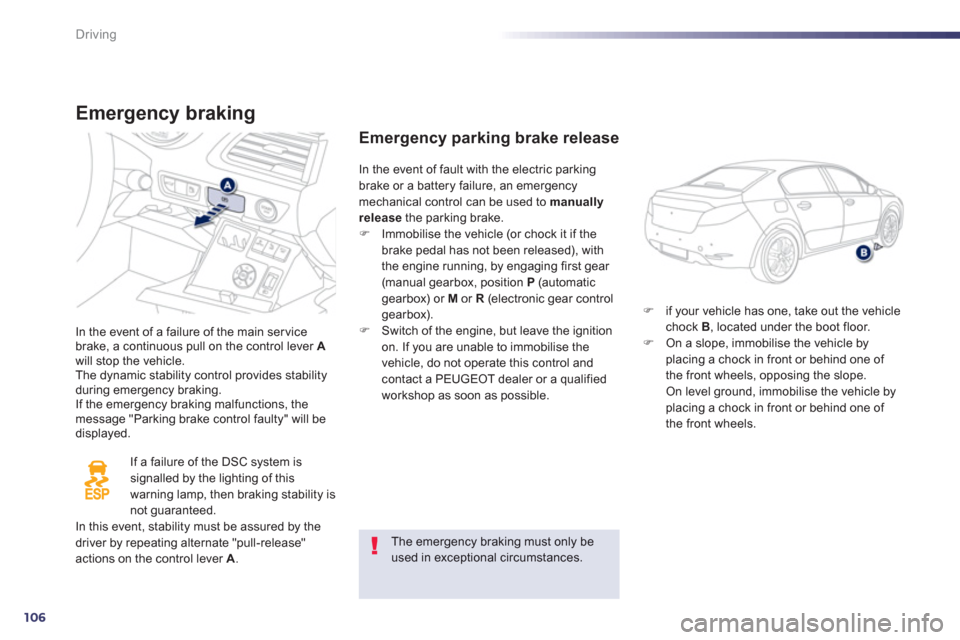
106
Driving
Emergency braking
In the event of a failure of the main servicebrake, a continuous pull on the control lever Awill stop the vehicle.The dynamic stability control provides stability during emergency braking.
If the emergency braking malfunctions, themessage "Parking brake control faulty" will be displayed.
If a failure of the DSC s
ystem is
signalled by the lighting of this
warning lamp, then braking stability is
not guaranteed.In this event, stability must be assured by thedriver by repeating alternate "pull-release" actions on the control lever A.
Emergency parking brake release
Fif your vehicle has one, take out the vehicle chock B , located under the boot floor. FOn a slope, immobilise the vehicle byplacing a chock in front or behind one of
the front wheels, opposing the slope. On level ground, immobilise the vehicle byplacing a chock in front or behind one of
the front wheels.
In the event o
f fault with the electric parkingbrake or a battery failure, an emergencymechanical control can be used to manually
releasethe parking brake.F Immobilise the vehicle (or chock it if the
brake pedal has not been released), with
the engine running, by engaging first gear (manual gearbox, position P(automatic gearbox) or M or R(electronic gear control
gearbox). F Switch of the engine, but leave the ignition on. If you are unable to immobilise the
vehicle, do not operate this control and
contact a PEUGEOT dealer or a qualified
workshop as soon as possible.
The emergency braking must only be used in exceptional circumstances.
Page 109 of 340
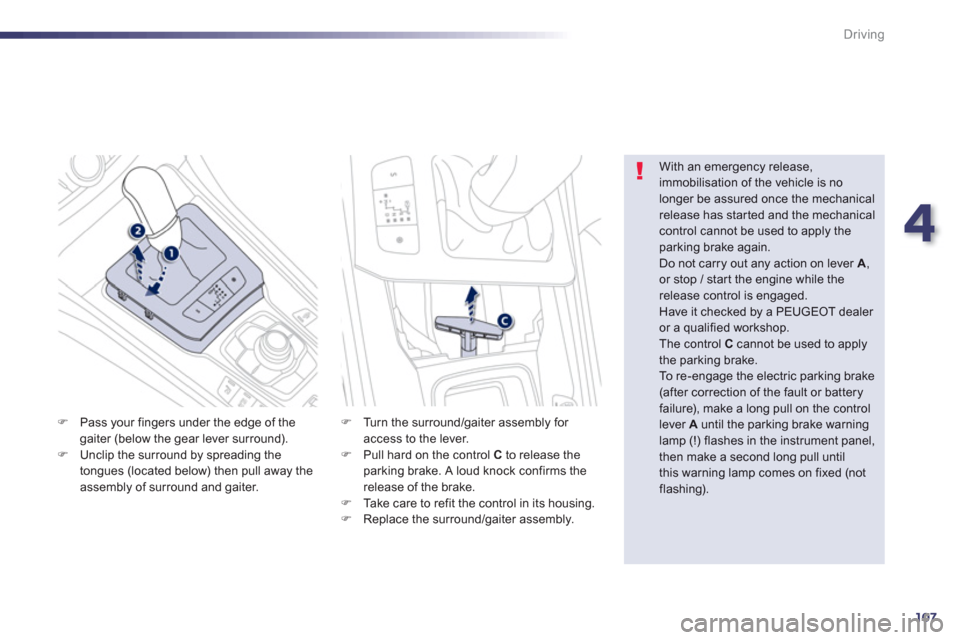
4
107
Driving
F Pass your fingers under the edge of the
gaiter (below the gear lever surround).F
Unclip the surround by spreading the
tongues (located below) then pull away theassembly of surround and gaiter.
With an emergency release,immobilisation of the vehicle is nolonger be assured once the mechanical release has started and the mechanical
control cannot be used to apply theparking brake again.
Do not carry out any action on lever A , or stop / star t the engine while therelease control is engaged.
Have it checked by a PEUGEOT dealer or a qualified workshop.
The control C
cannot be used to apply the parking brake.
To r e - e ngage the electric parking brake(after correction of the fault or batteryfailure), make a long pull on the controllever A
until the parking brake warninglamp (!) flashes in the instrument panel, then make a second long pull until this warning lamp comes on fixed (not flashing).
FTurn the surround/gaiter assembly for
access to the lever.FPull hard on the control C
to release theparking brake. A loud knock confirms the release of the brake. FTake care to refit the control in its housing.
FReplace the surround/gaiter assembly.
Page 110 of 340
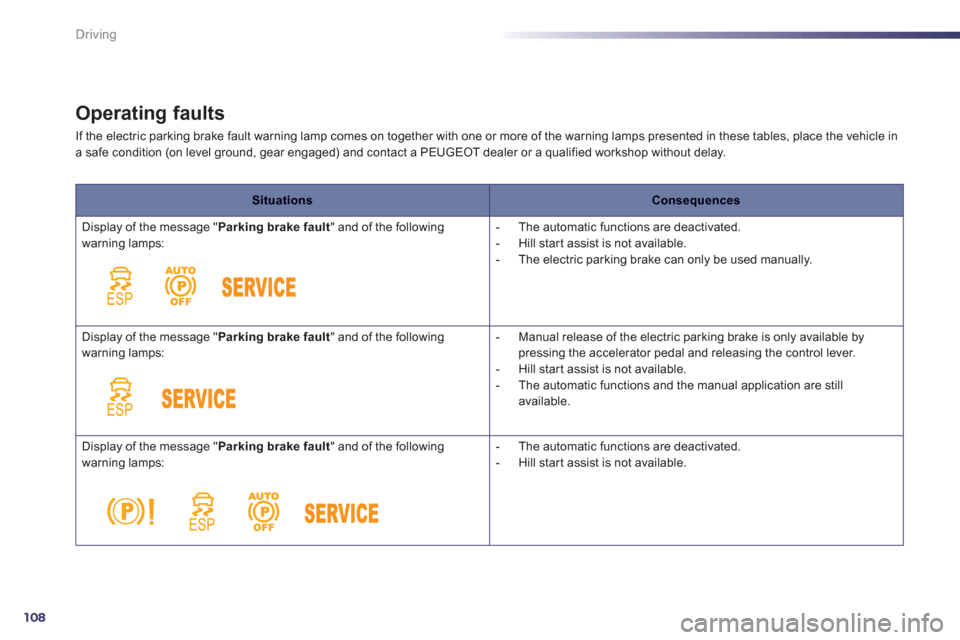
108
Driving
Operating faults
If the electric parking brake fault warning lamp comes on together with one or more of the warning lamps presented in these tables, place the vehicle ina safe condition (on level ground, gear engaged) and contact a PEUGEOT dealer or a qualified workshop without delay.
SituationsConsequences
Displa
y of the message "Parking brake fault" and of the following
warning lamps:
- The automatic functions are deactivated.
- Hill start assist is not available.
- The electric parking brake can only be used manually.
Displa
y of the message "Parking brake fault" and of the following
warning lamps:
- Manual release of the electric parking brake is only available by pressing the accelerator pedal and releasing the control lever.
- Hill start assist is not available.
- The automatic functions and the manual application are still available.
Displa
y of the message "Parking brake fault" and of the following
warning lamps:
- The automatic functions are deactivated.
- Hill start assist is not available.
Page 111 of 340
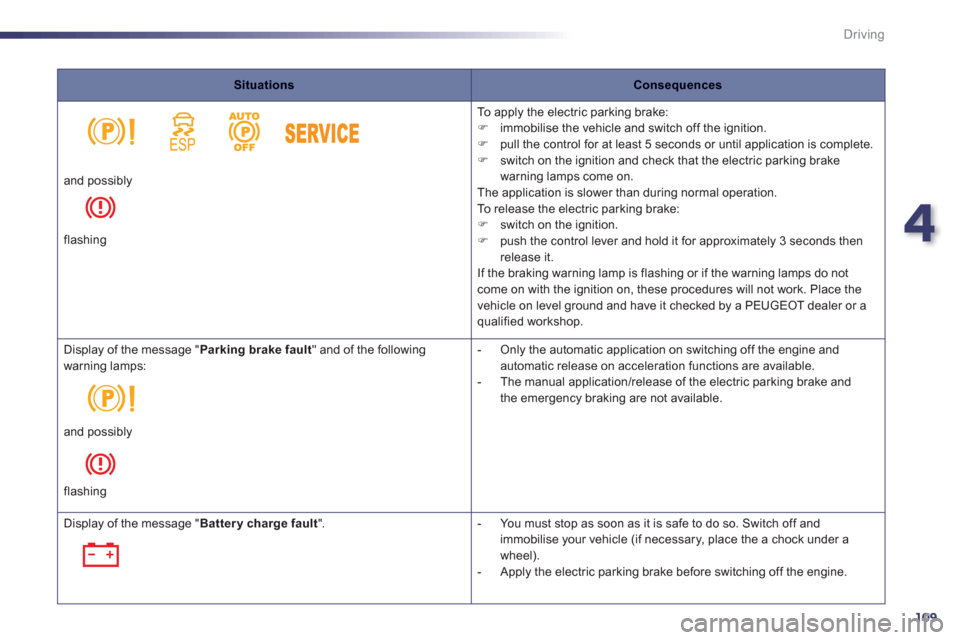
4
109
Driving
SituationsConsequences
To apply the electric parking brake: F immobilise the vehicle and switch off the ignition. F
pull the control for at least 5 seconds or until application is complete.F
switch on the ignition and check that the electric parking brake
warning lamps come on.
The application is slower than during normal operation.
To release the electric parking brake:
F
switch on the ignition. F
push the control lever and hold it for approximately 3 seconds then
release it.
If the braking warning lamp is flashing or if the warning lamps do not come on with the ignition on, these procedures will not work. Place the
vehicle on level ground and have it checked by a PEUGEOT dealer or aqualified workshop. and possibl
y
flashing
Display of the message "Parking brake fault" and of the following warning lamps:
- Only the automatic application on switching off the engine andautomatic release on acceleration functions are available.
- The manual application/release of the electric parking brake and
the emergency braking are not available.
and possibly
flashin
g
Display of the message "Battery charge fault".
- You must stop as soon as it is safe to do so. Switch off and
immobilise
your vehicle (if necessary, place the a chock under a
wheel).
- Apply the electric parking brake before switching off the engine.
Page 112 of 340
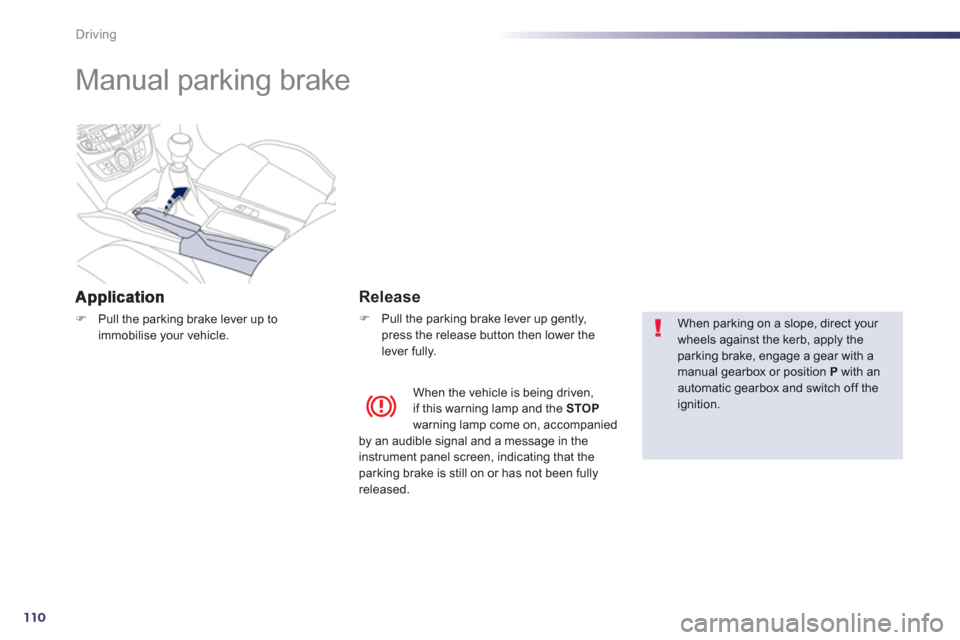
110
Driving
Manual parking brake
FPull the parking brake lever up toimmobilise your vehicle.
Release
F
Pull the parking brake lever up gently,
press the release button then lower the
lever fully.
When parking on a slope, direct your wheels against the kerb, apply theparking brake, engage a gear with amanual gearbox or position P
with an automatic gearbox and switch off theignition. When the vehicle is being driven,
if this warning lamp and the STOPwarning lamp come on, accompanied by an audible signal and a message in the
instrument panel screen, indicating that the
parking brake is still on or has not been fullyreleased.
Page 121 of 340
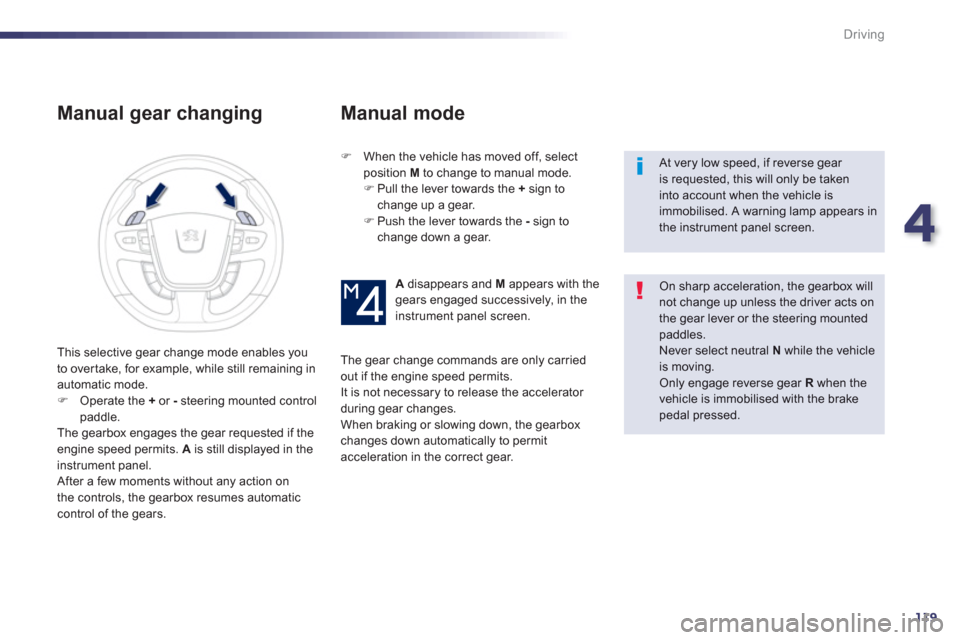
4
119
Driving
Manual gear changing
FWhen the vehicle has moved off, select
position M to change to manual mode. F
Pull the lever towards the +sign to change up a gear. F
Push the lever towards the -sign to change down a gear.
At very low speed, if reverse gear is requested, this will only be takeninto account when the vehicle isimmobilised. A warning lamp appears in the instrument panel screen.
On sharp acceleration, the gearbox willnot change up unless the driver acts onthe gear lever or the steering mountedpaddles. Never select neutral N
while the vehicleis moving. Only engage reverse gear Rwhen thevehicle is immobilised with the brake pedal pressed.
Adisappears and M
appears with thegears engaged successively, in the instrument panel screen.
The
gear change commands are only carried
out if the engine speed permits.It is not necessary to release the accelerator during gear changes. When braking or slowing down, the gearbox
changes down automatically to permitacceleration in the correct gear. This selective
gear change mode enables you
to over take, for example, while still remaining in automatic mode.F Operate the +
or -
steering mounted controlpaddle.
The gearbox engages the gear requested if the engine speed permits. A
is still displayed in theinstrument panel.
After a few moments without any action on
the controls, the gearbox resumes automaticcontrol of the gears.
Manual mode
Page 122 of 340

120
Driving
You must press the brake pedal when star ting the engine.
Whatever the circumstances, you must manually apply the parking brake when parking, unless the parking brake isprogrammed in automatic mode.
When immobilising the vehicle, with the engine running, you must place the gear lever in neutral N.Before carrying out any work in the engine compar tment, check that the
gear lever is in neutral N
and that the parking brake is applied.
Stopping the vehicle
With the ignition on, theflashing of this warning lamp, accompanied by an audiblesignal and a message in the instrument panelscreen, indicates a malfunction of the gearbox.
have it checked by PEUGEOT or a qualified
workshop. Be
fore switching off the engine, you can
choose to:
- move to position N
to engage neutral,
- leave the gear engaged; in this case, it will
not be possible to move the vehicle.
In both cases,
you must apply the parking brake to immobilise the vehicle.
Operating fault Creep function
(moving without pressing
the accelerator)
This function greatly facilitates manoeuvringof the vehicle at low speed (when parking, in a
traffic jam…).
With the engine at idle, parking brake released
and position A , M
or Rselected, the vehicle moves
as soon as you take your foot off
the brake pedal (even without pressing the accelerator pedal).
For your safety, this function is only activated
if you press the brake pedal when changing to forward drive or reverse. It is deactivated on opening the driver's door. Closing the door and then pressing the brake or accelerator pedal reactivates the function.
The vehicle does not move without pressing the accelerator pedal if the lever stays in position Nfor more than2 seconds
with the engine running,and the brake pedal is not pressed before selecting position A, M
or R
.
Never leave children inside the vehicle without supervision when the engine is running.
Page 123 of 340
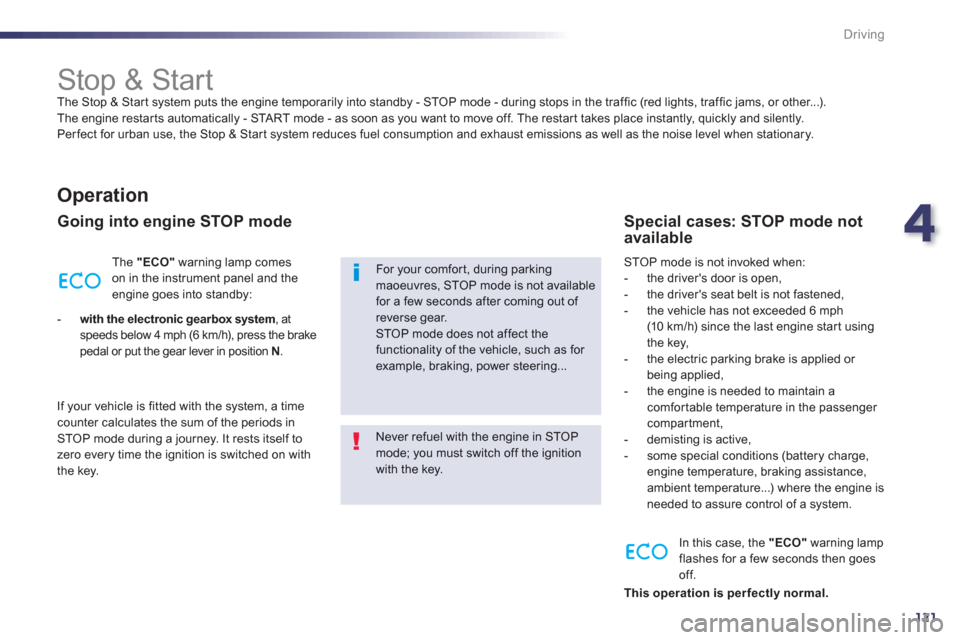
4
121
Driving
Stop & Start
The Stop & Star t system puts the engine temporarily into standby - STOP mode - during stops in the traffic (red lights, traffic jams, or other...).
The engine restar ts automatically - START mode - as soon as you want to move off. The restart takes place instantly, quickly and silently.
Per fect for urban use, the Stop & Star t system reduces fuel consumption and exhaust emissions as well as the noise level when stationary.
Operation
Going into engine STOP mode
The "ECO"warning lamp comes
on in the instrument panel and the
engine goes into standby:
-
with the electronic gearbox system, at speeds below 4 mph (6 km/h), press the brakepedal or put the gear lever in position N.
I
f your vehicle is fitted with the system, a timecounter calculates the sum of the periods in
STOP mode during a journey. It rests itself to
zero every time the ignition is switched on with
the ke
y.
Never refuel with the engine in STOPmode; you must switch off the ignition with the key.
For your comfort, during parking maoeuvres, STOP mode is not available for a few seconds after coming out of reverse gear. STOP mode does not affect the functionality of the vehicle, such as for example, braking, power steering...
Special cases: STOP mode notavailable
STOP mode is not invoked when:
- the driver's door is open,
- the driver's seat belt is not fastened,
- the vehicle has not exceeded 6 mph (10 km/h) since the last engine star t using
the key,
- the electric parking brake is applied or
being applied,
- the engine is needed to maintain acomfor table temperature in the passenger compartment,
- demisting is active,
- some special conditions (battery charge, engine temperature, braking assistance,
ambient temperature...) where the engine isneeded to assure control of a system.
In this case, the
"ECO"
warning lamp
flashes for a few seconds then goesoff.
This operation is per fectly normal
.